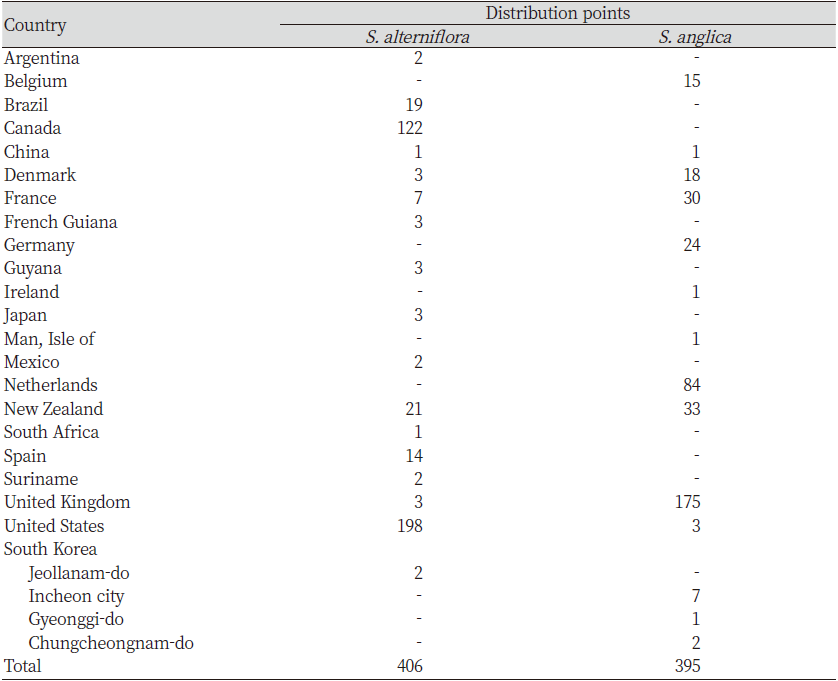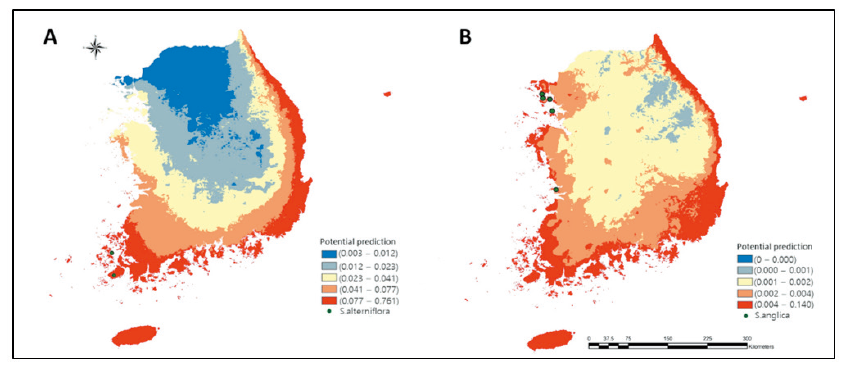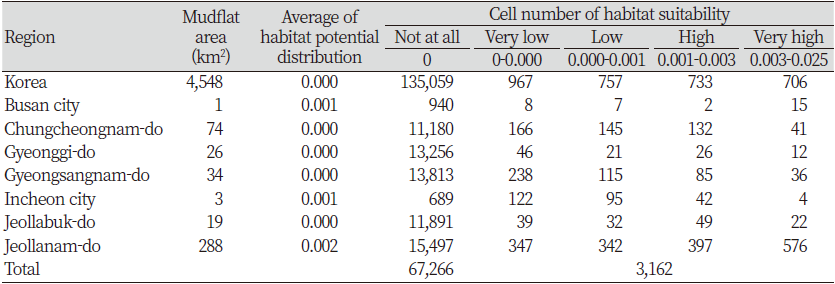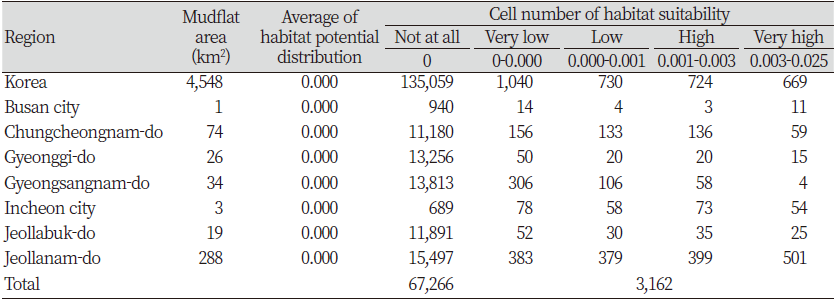서 언
19세기 후반부터 외래침입종에 대한 문제를 인식하고 관리하려는 노력들은 지속해왔으나(Beeson, 1934), 침입초기 미미한 영향으로 큰 변화를 느끼지 못하기 때문에 빠르게 대처하지 못하는 경우들이 대부분이었다(Tobin, 2018). 이에 IUCN (International Union for Conservation of Nature, 세계자연보전연맹)에서는 외래침입종의 악영향이 심각해짐을 인지하여 1992년 생물다양성협약(Convention on Biological Diversity, CBD)을 통해 대상종을 선정하여 관리하도록 권고하였다(Mace et al., 1992). 외래침입종은 소수의 도입종만으로도 확산됨에 따라 연쇄적인 다양한 손실들이 발생하며, 의도적 혹은 비의도적으로 유입을 허락한 지역은 복원하는데 막대한 노력과 비용이 발생하게 된다(Andersen et al., 2004; Davies and Johnson, 2011). 유럽, 미국, 일본, 중국 등의 전세계에서 보고된 연구에 따르면 외래침입종을 관리하기 위해 연간 수천 억 달러의 손실 및 소모가 발생하고 있다고 밝혔다(Callaway and Maron, 2006; Kettunen et al., 2009). 세계적으로 미기록종 등과 같이 예상치 못하는 종들이 유입되고 있고, 이상기후 현상으로 인해 앞으로도 지속적인 증가가 이루어 질것이라고 예측하고 있다(Essl et al., 2020). 이에 따라 산업화와 기후변화 등으로 증가하는 외래침입종에 대응하여 확산 예측 및 관리방법에 관한 관심이 높아지고 있다(Mack et al., 2000; Yoccoz et al., 2001).
Spartina 속 식물은 유럽, 북아메리카 등에 분포하고 있으며 총 17여종으로 알려져 있다(Hedge et al., 2003). 국내에는 이들 중 갯줄풀(Spartina alterniflora Loisel)과 영국갯끈풀(S. anglica C.E. Hubb) 2종이 정착하고 있다. 대서양과 북아메리카가 원산지로 알려진 갯줄풀은 주로 미국의 노스캐롤라이나, 조지아 및 플로리다에서 유래했다고 보고되었고(Bernik et al., 2016; Strong and Ayres, 2013; Wang et al., 2006), 국내에서는 전라남도 진도군에서 발견되었다고 보고하였다(Kim, 2016; Kim et al., 2015b). 영국과 유럽이 원산지로 알려진 영국갯끈풀은 19세기 영국 사우샘프턴 워터(Southampton Water)에서 처음 보고되었고(Gray and Raybould, 1997), 국내에서는 2015년에 인천광역시 강화도에서 발견되었다(Kim et al., 2015b). 갯줄풀과 영국갯끈풀은 해안 점토를 묶어 조밀한 뿌리 체계를 형성하고 줄기는 파도에너지를 감소시켜 자연적인 해안 방파제로 알려져 여러 국가에서 수입하여 식재하였다(Allen and Webb Jr., 1982; Carrion, 2016; Scyphers et al., 2011). 그 결과 영국, 북유럽, 호주, 뉴질랜드, 미국, 중국 등의 국가에서 해안가를 중심으로 식재한 곳 이외에 곳으로 확산되는 것에 대한 우려가 높아졌다(Zhang et al., 2004; Zuo et al., 2012). 이 외래침입종들은 기후변화가 심각해질수록 침입능력이 증가하여 현재보다 많은 곳으로 확산이 이루어질 것으로 보고되었다(Loebl et al., 2006; Nehring, 2003). 가장 큰 피해는 생태적으로 높은 가치를 가지는 갯벌과 해안을 녹색초지로 변화시키고 무척추동물과 해안조류 등의 서식지를 감소시켜 생태계를 교란시키며(Norman and Patten, 1994), 양식장에서 수산물의 수확량을 감소시켜 막대한 경제적 손실을 야기하는 것으로 알려져 있다(Dumbauld et al., 2009). 국내에서도 갯줄풀과 영국갯끈풀의 위해성을 인지하여 2016년에 해양수산부와 환경부에서 유해해양생물 및 생태계교란생물로 지정하였고(Ministry of Environment, 2016; Ministry of Oceans and Fisheries, 2020), 이들로 인한 경제적·생태적 피해를 입은 각 피해지역에 적극적인 지원과 모니터링 계획을 밝혔다. 두 외래침입종은 갯벌이라는 특수 서식지로 인해 아직까지 완벽한 제거가 어려운 상황이며 조사의 어려움으로 관리에 어려움을 겪고 있다. 따라서 타 지역으로 확산되는 것을 방지하고 사전에 예방 가능한 정보를 구축할 필요성이 있다.
외래침입종 예측 연구로 가장 많이 사용되는 방법은 종분포모형(species distribution models, SDMs)이다. 종분포모형은 잠재적 서식지를 예측하거나, 특정 분포지에 제한적으로 서식하고 있는 외래침입종에 대한 확산가능성을 예측하는 도구로도 사용되어지고 있다(Kleinbauer et al., 2010). 국내에서는 종분포모형을 이용하여 외래침입종의 잠재적 확산을 예측할 때, 현지조사에서 확인된 분포연구들을 중점으로 연구되어 지고 있다(Cho et al., 2020; Kim et al., 2015a; Lee et al., 2018; Lim and Hwang, 2006). 갯줄풀과 영국갯끈풀의 국내 분포정보는 10개 이하의 분포지점 데이터를 가지고 있고, 종분포모형을 수행할 때, 지리적으로 분포자료가 편향되면 잠재적 서식지와 실제 서식지가 다르게 나타날 수 있다(Barnes et al, 2014). 따라서 본 연구는 MaxEnt를 이용하여 국내에 침입한 Spartina 속 외래침입종 갯줄풀과 영국갯끈풀의 전세계 분포지점을 잠재적 확산 지역 예측에 활용하였다. 그리고 Spartina 속 외래침입종이 생육 불가한 육지까지 예측되는 부분을 제거하기 위해 갯벌 비오톱(biotope)을 활용하여 국내 확산 가능 지역을 파악하고 향후 효율적인 관리방안을 수립하여 이를 적극적으로 모니터링 할 수 있는 정보를 제공하고자 하였다.
재료 및 방법
Spartina 속 외래침입종의 분포자료 수집
환경부와 해양수산부에서 2016년부터 2020년까지 조사한 분포자료에 따르면, 갯줄풀과 영국갯끈풀은 서해안을 중심으로 인천광역시 강화도, 영종도, 신도, 경기도 대부도, 충청남도 서천, 전라남도 진도 등 7개의 지역에서도 확인되었다고 하였다(Ministry of Environment, 2016; Ministry of Oceans and Fisheries, 2020). 이 외 국내에서 보고되는 보도자료를 통해 인천광역시 능원이해변, 전라남도 신안군, 경기도 안산시 시화호에서 추가적으로 발견되었음을 확인하였다(ICIB, 2019). 따라서 종분포모형에 이용된 국내 분포지점 데이터는 인천광역시 강화도, 영종도, 신도, 능원이해변, 경기도 시화호, 대부도, 충청남도 서천, 전라남도 진도, 신안군에서 갯줄풀 2지점, 영국갯끈풀 10지점으로 데이터를 구축하였다(Table 1). 해외에서 분포하고 있는 갯줄풀과 영국갯끈풀의 분포지점은 세계생물다양성정보기구(Global Biodiversity Information Facility [GBIF], www.gbif.org)에서 제공하는 GPS 좌표를 참고하였고, 종분포모형에 사용된 해외 분포지점데이터는 갯줄풀이 404지점, 영국갯끈풀이 385지점으로 데이터를 구축하였다(Table 1).
기후 자료 수집
기후자료를 이용하여 모델을 구축하기 위해 Worldclim ver. 2 (Worldclim, 2022)에서 제공하는 19개의 생물기후인자를 활용하였고, 다중공선성(多重共線性, Multicollinearity) 제거를 위해 생물인자들 간의 상관성이 높은 인자들을 제외 후 모델에 적용하였다(Lee et al., 2018). 모델에는 생물기후인자 19개 중 연평균온도(BIO1)와 연평균강수량(BIO12)을 기준으로 0.7 이상의 높은 상관성을 갖는 인자들을 제외하여 연평균온도(BIO1)와 연평균강수량(BIO12), 평균일교차(BIO2), 온도계절성(BIO4), 연온도범위(BIO7), 강수량계절성(BIO15) 총 6개의 인자가 선발되었고, 모든 데이터는 1 km2 공간해상도를 이용하였다. 다중공선성 제거는 ArcGIS ver. 10.8 (ESRI, Redlands, California, USA)에서 활용이 가능한 SDMtoolbox ver. 2.5 (www.sdmtoolbox.org)를 이용하여 Correlations Statistics 툴로 확인하였다.
종분포모형 MaxEnt를 이용한 평가방법
Spartina 속 외래침입종 갯줄풀과 영국갯끈풀의 잠재적 확산 지역 예측을 위해 종분포모형 중 오픈소스로 배포되어 가장 널리 사용되고 있는 MaxEnt (ver. 3.4.4, https://github.com/mrmaxent/Maxent; Li et al., 2021; Phillips and Dudik, 2008) 모델을 이용하였다. 모델에는 국내 분포지점과 해외분포지점 데이터를 이용하였으며, 비슷한 기후조건에서 확인되는 분포지점들을 10 km 간격으로 제거하여 분포지점을 재구축하였다(Veloz, 2009). MaxEnt 모델에서 추출되는 결과값은 0과 1사이의 값으로 해석이 가능한 로지스틱 형식의 출력 값으로 설정하였으며, 모델 성능을 평가하기 위해 AUC (area under curve) 방법을 이용하였다. AUC 값은 기본값 0.5에서 1까지 나타나며 1과 가깝게 나타날수록 좋은 모델로 판단하고 있다(Hosmer and Lemeshow, 2000). 또한 결과에 대하여 환경변수들의 기여 정도와 모형 훈련 결과에서 중요하게 AUC 값을 감소시키는 변수를 파악하기 위해 변수 기여도(percent contribution)와 변수 중요도(permutation importance)를 확인하였다(Choi et al., 2015; Phillips et al., 2006). MaxEnt 모델을 통해 생성된 잠재적 서식지 예측 지도는 ArcGIS ver. 10.8을 이용하여 재구성하였으며 잠재적 확산 지역 예측 평가는 예측 범위를 동일한 확률로 그룹화 시키는 분위수를 활용하여 평가하였다(Tehrany et al., 2013).
서식지 확산 예측 평가
MaxEnt 모델을 통해 확인된 국내 Spartina 속 외래침입종의 잠재적 서식지 예측지도에서 서식지가 아닌 지역까지 과도하게 예측되는 부분들을 제거하기 위해 환경공간정보서비스의 2020년 전국 세분류 토지피복지도를 활용하였고(EGIS, 2020), 기후격자에 맞춰 갯벌 면적을 추출한 후 격자당 면적비를 계산하여 격자 지도를 구축하였다(Lee et al., 2018). 서식지가 아닌 지역까지 예측되는 분포범위를 제한하기 위해 국내 토지이용도상의 갯벌 비오톱 지도와 MaxEnt 모델로 평가된 잠재적 서식지 예측지도를 ArcGIS에서 Raster calculator를 이용하여 서로 곱하여 계산하여 재구성하였다. 그리고 GIS 격자 내에서 분위수 방식으로 예측 범위를 설정하였고, 재구성한 잠재적 서식지 예측지도 상에서 Spartina 속 외래침입종이 한 종 이상 발견되면 확산이 가능하다고 판정하고, 갯벌내의 서식지로 제한하여 잠재적 확산 지역을 평가하였다.
결과
Spartina 속 외래침입종의 잠재적 확산 지역 예측
MaxEnt모델을 이용한 잠재적 확산 지역 예측
MaxEnt 모델을 통해 갯줄풀과 영국갯끈풀의 국내 분포지점 데이터가 적은 것을 고려하여 국내와 해외에서 발생하고 있는 분포지점 데이터로 국내 잠재적 확산 지역을 예측하였다. 두 외래침입종의 잠재적 확산 지역 예측에는 6개의 생물기후인자와 갯줄풀이 406개의 분포지점 데이터 중 317개의 분포지점의 데이터를, 영국갯끈풀이 395개의 분포지점 데이터 중 262개의 분포지점을 MaxEnt모델을 이용하여 분석한 결과 두 종 모두 500번의 반복 훈련으로 예측 정확도를 나타내는 AUC 값은 각각 0.97과 0.986로 나타났다(Table 2).
|
Table 2. Summary of MaxEnt model for distribution of Spartina alterniflora and S. anglica in the world. 
|
전세계 잠재적 서식지 예측지도에서는 두 식물 모두 유럽에서 높은 수치로 잠재적 확산 지역이 예측되었으며, 대한민국은 다른 국가들 보다 상대적으로 낮은 값으로 나타났고 갯줄풀보다 영국갯끈풀에서 더 낮은 값으로 확인되었다(Fig. 1). 국내 지역통계량을 확인한 결과, 잠재적 확산 지역 예측 확률은 갯줄풀의 경우 국내 평균값이 0.046, 최대값이 0.761로 나타났고, 영국갯끈풀의 경우 국내 평균이 0.003, 최대가 0.140로 확인되었다(Table 3). 지방자치단체별로 비교한 결과로는 제주도에서 가장 높은 확률로 확산이 가능함을 확인하였고, 그 다음으로 부산광역시, 울산광역시, 전라남도로 갯줄풀과 영국갯끈풀이 유사하게 나타났다(Table 3). 이는 갯벌 서식지가 아닌 지역을 제외하지 않고 확인한 결과이며, 두 종 모두 예측 결과가 남부지방에서 높은 가능성으로 확산이 될 것으로 나타났다(Fig. 2).
환경변수 기여도
잠재적 서식지 예측지도 결과에 대하여 6가지 생물기후인자 환경변수들의 기여 정도를 파악하기 위해 변수기여도(percent contribution)와 변수중요도(permutation importance)를 확인하였다. 갯줄풀의 변수기여도의 경우 연평균강수량이 가장 높은 값을 보였으며, 변수 중요도의 경우 연평균기온, 연평균강수량, 계절강수량 순으로 확인되었다(Table 4). 영국갯끈풀의 변수기여도의 경우 연간온도범위, 연평균기온, 연평균강수량 순으로 나타났고, 변수 중요도의 경우 연평균기온이 가장 높은 값으로 확인되었다(Table 4). 따라서 환경변수 중요도 결과, 갯줄풀은 연평균강수량이, 영국갯끈풀은 연평균기온이 잠재적 확산 지역을 결정짓는 요인으로 각각 판단되었다.
|
Table 4. Estimates of relative contributions of the environmental variables for modeling of Spartina anglica and S. anglica using the MaxEnt model. 
|
갯벌 서식지에 따른 국내 잠재적 확산 지역 예측
갯벌 서식지 내 잠재적 확산 지역 예측 통계량
Spartina 속 외래침입종 갯줄풀과 영국갯끈풀의 국내와 해외 분포지점 데이터를 활용한 잠재적 서식지 예측지도에서 서식지가 아닌 내륙지역이나 그 밖에 지역에서 예측되어 나타난 부분들을 제거하기 위해 갯벌 서식지 비오톱 면적의 비율을 산출하였고, MaxEnt 모델에서 예측된 잠재적 서식지에 갯벌 비오톱 면적 격자 지도를 적용하여 갯줄풀과 영국갯끈풀의 확산 예측 지역을 재구축하였다. 이를 통해 갯벌 서식지 지역에서 갯줄풀과 영국갯끈풀의 잠재적 확산 예측 지역의 GIS 격자의 수를 확인한 결과, 인천광역시, 경기도, 충청남도, 전라북도, 전라남도, 부산광역시, 경상남도 총 7개의 지역에서 확인되었다. 갯벌 서식지 지역에서 갯줄풀과 영국갯끈풀의 잠재적 확산 예측 분포를 GIS격자내 개체 수를 히스토그램을 이용하여 확인해 본 결과, 두 종 모두 가장 높은 확률로 많은 개체수가 전라남도에서 확인되었다(Table 5 and 6). 갯벌 서식지 내에서 잠재적 확산 예측 분포 확률은 평균은 갯줄풀의 경우 전라남도에서 가장 높은 확률로 확산 가능하다고 예측하였고, 그 다음으로 인천광역시, 부산광역시에서 높은 확률로 확인되었다(Table 5). 영국갯끈풀의 경우 전세계 분포지점이 상대적으로 갯줄풀보다 적어 확인되지 않았으나 GIS 격자내 개체 수는 갯줄풀과 유사하게 확인되었다(Table 6).
갯벌 서식지 면적비 지도로 확인한 위험 관리 지역 선정
잠재적 확산 지역 예측 결과를 갯벌 서식지 면적비를 이용하여 재구성 후 확인된 예측도에서 7지역의 갯벌 서식지 중 면적대비 높은 확률의 개체수로 파악된 3 지역의 위험 관리 지역을 선정하였다. 위험 관리지역으로 확인된 인천광역시, 전라남도, 부산광역시 3 지역에서 갯벌이 존재하는 항공사진에 기존 분포지점을 표시하고 잠재적 서식지 예측 지도를 중첩하여 확인하였다.
그 결과, 갯줄풀은 인천광역시 신도에서 인천국제공항 주변 그리고 시화호 인근으로 확산될 것이라고 확인되었다(Fig. 3. 1a). 전라남도에서는 신안군, 무안군 등의 전라남도에 있는 대부분의 갯벌에서 높은 확률로 확산되고 있음을 확인되었고(Fig. 3. 2a), 아직 확산이 진행되지 않은 지역인 부산광역시에서도 부산시 신항만과 가덕도부터 을숙도 인근 갯벌에서 높은 확률로 확산이 예측되었다(Fig. 3. 3a). 영국갯끈풀도 갯줄풀과 동일한 곳 주변으로 비슷하게 나타났으나, 상대적으로 갯줄풀보다 북부지방에서 높은 확률로 확산이 예측되는 곳들이 많았으나(Fig. 3. 1b), 남부지방에서는 낮은 확률로 확산이 예측되는 곳들이 많았다(Fig. 3. 2b and 3b).
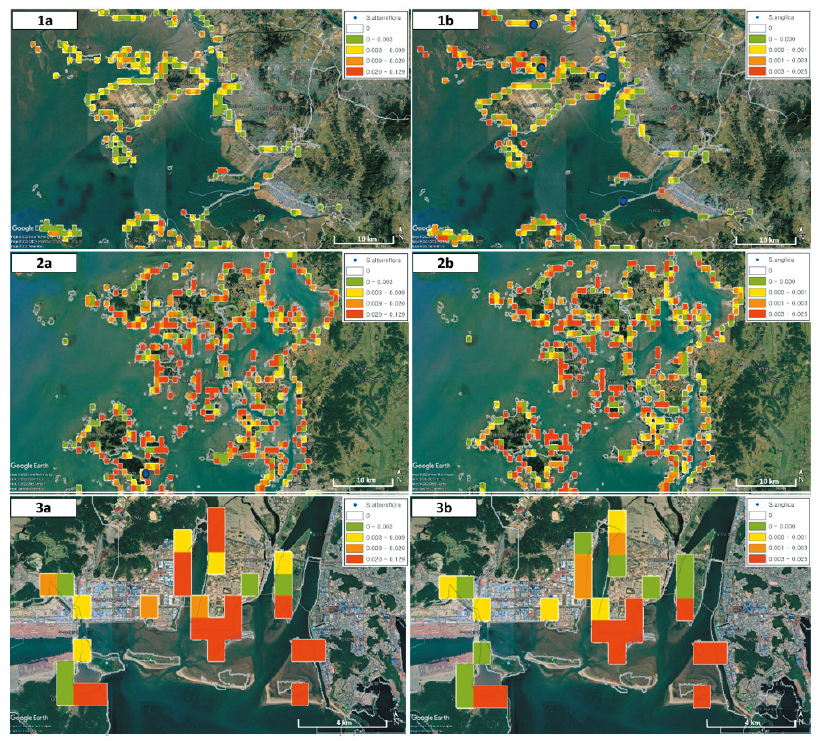
Fig. 3. Prediction of potential habitat for Spartina spp. in Korea using MaxEnt model and Biotope maps. 1a: Potential habitat of S. alterniflora in Incheon city; 1b: Potential habitat of S. anglica in Incheon city; 2a: Potential habitat of S. alterniflora in Jeollanam-do; 2b: Potential habitat of S. anglica in Jeollanam-do; 3a: Potential habitat of S. alterniflora in Busan city; 2b: Potential habitat of S. anglica in Busan city.
고찰
특정 외래침입종들은 서식지의 영향을 많이 받아 제한된 곳에서만 생육하는 특징을 가지고 있고 이러한 종들은 잠재적 확산 예측을 할 때 서식지 지도를 이용하면 데이터의 신뢰도를 높일 수 있다(Fattorini, 2010; Urbani et al., 2017; Van Hoey et al., 2011). 그러나 생태계교란종으로 지정된 갯줄풀(S. alterniflora)와 영국갯끈풀(S. anglica)은 국내에 다른 생태계교란종에 비해 분포지점 데이터 수가 현저히 적은 특징을 가지고 있어 MaxEnt 모델을 이용하여 잠재적 확산 지역을 예측할 때 결과에 대한 오류를 범할 수 있다는 문제점을 가지고 있다(Wisz et al., 2008). 이에 대해 호주 뉴잉글랜드 대학에서는 MaxEnt를 이용하여 잠재적 확산 예측을 할 때, 국내분포지점 데이터와 해외 분포지점 데이터를 모두 포함한 데이터를 이용한 결과가 미래에 대한 적응성과 확산 및 정착에 대해 설명력이 좋은 모델을 보여준다고 보고하였다(Shabani and Kumar, 2015). 본 연구에 따르면 국내와 해외에서 확인된 국내와 해외에서 확인된 갯줄풀과 영국갯끈풀의 분포지점 데이터를 이용하여 MaxEnt 모델로 국내 잠재적 확산 지역을 예측했을 때, AUC 값이 0.9 이상 모델의 설명력을 확인하였다. 또한 두 외래침입종은 정착과 확산을 할 때 이상기온이 지속될수록 확산 능력이 증가하고(Nehring, 2003), 강수량이 분포밀도를 결정하는 특징이 있다(Hedge and Kriwoken, 2000). 이는 환경변수 중요도 검사를 통해 상대적으로 남쪽에 분포하는 갯줄풀은 온도보다는 강수량에 의해 영향을 많이 받고, 북쪽에 분포하는 영국갯끈풀은 기온에 영향을 많이 받을 것이라고 예측되었다. 그리고 갯벌 서식지에서만 서식하는 특징을 고려하여 갯벌 비오톱 지도로 갯벌에서의 잠재적 확산 지역을 평가하였을 때, 갯줄풀이 남부지방에서 영국갯끈풀이 북부지방에서 높은 값으로 예측되었으며, 갯벌 면적 대비 높게 예측된 인천광역시와 전라남도, 부산광역시 3 곳의 확산 위험 관리 지역을 선정하였다. 확산 위험 관리 지역 선정에서 제주도는 갯벌 비오톱 지도를 고려하지 않았을 때 높은 확산이 예측되었으나, 갯벌 서식지가 존재하지 않기 때문에 확산 위험 관리 지역에서 제외되었다. 본 연구결과를 통해 적은 분포지점의 외래침입종을 예측할 때 국내와 해외 분포지점 데이터를 활용한 모델이 높은 설명력으로 예측되었고, 서식지 비오톱 지도를 이용하면 비서식 지역을 제외하여 구체적인 예측결과를 확인할 수 있다고 판단하였다. 따라서 향후 국내에서 분포 수가 적은 종이나 도입이 우려되는 종의 확산 예측 대한 다양한 연구가 필요할 것으로 보이며, 갯벌 서식지 3 지역의 확산 위험 관리 지역에 대한 모니터링과 경제적, 생태적으로 가치가 큰 갯벌 서식지에 위협을 주는 외래침입종의 대한 여러 연구가 이루어져 할 필요성이 있다.
요 약
갯줄풀(Spartina alterniflora Loisel)과 영국갯끈풀(S. anglica C.E. Hubb)은 갯벌에서 생육하고 세계100대악성잡초로 알려져 있는 위해성이 높은 외래종이다. 국내에서도 갯줄풀과 영국갯끈풀의 피해로 인해 수 억원의 손실을 입고 있으나 이들의 갯벌 서식지의 특수성으로 인해 관리에 어려움을 겪고 있다. 본 연구에서는 종분포모형 MaxEnt모델을 통해 국내 생태계교란종인 갯줄풀과 영국갯끈풀의 국내와 해외에서 발생하고 있는 분포지점 데이터를 이용하여 잠재적 확산 지역을 예측하였다. 또한 갯벌 서식지에서 서식하는 특징을 고려하여 구체적인 결과를 얻기 위해 잠재적 서식지 예측지도와 현재 갯벌 서식지 지도를 중첩하였으며 이를 통해 확산 위험 관리 지역을 평가하고자 하였다. 그 결과, 갯줄풀과 영국갯끈풀 두 외래침입종 모두 남부지방으로 확산이 가능할 것으로 예측되었고, 확산 위험 관리 지역에는 인천광역시, 전라남도, 부산광역시가 선정되었다. 이는 향후 국내에서 분포지점 데이터가 적은 위해우려종에 대한 종분포모형 수행방법을 제안하고, 갯벌 서식지에서 생육하는 생태계교란종에 대해 적극적으로 모니터링 할 수 있는 정보를 제공하고자 하였다.
주요어: 갯줄풀, 영국갯끈풀, 외래종, 위해성 평가, 종분포모형
Acknowledgements
This study was supported by joint research project from Ministry of Environment, Republic of Korea (project number: 20180022700013).
Authors Information
Gaeun Lee, Hankyong National University, Researcher
Taeyang Choi, Hankyong National University, Researcher
Pradeep Adhikari, Hankyong National University, Reseracher Professor
Yong-Ho Lee, Hankyong National University, Reseracher Professor
In-Yong Lee, Hankyong National University, Reseracher Professor
Sun-Hee Hong, Hankyong National University, Reseracher Professor

